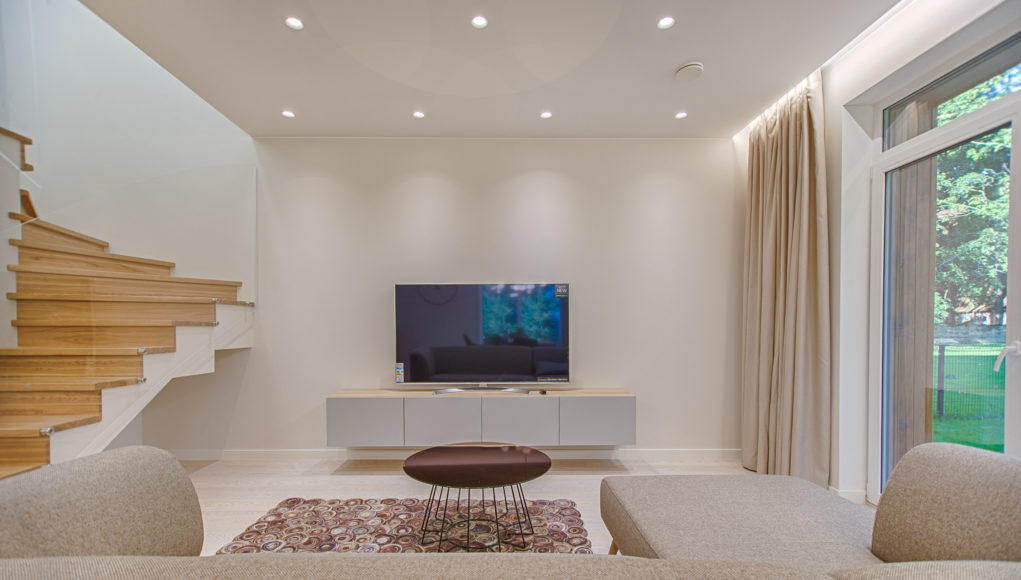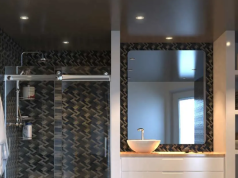There’s no getting away from it. Having low ceilings is a challenge when it comes to lighting.
What makes it worse is everywhere you look. You are bombarded with images of homes with tall ceilings with all sorts of interesting and amazing lighting fixtures such as chandeliers and pendant lighting. From home design and decor magazines to Pinterest and Instagram, they all seem to be fixated on high ceilings, so where does that leave you?
While low ceilings do have limitations, there are steps you can take to maximize the effects of your light fixtures. In this article, we are going to explore the different ways we can make the best of having low ceilings. Join us on our voyage of discovery!
How Do You Light A Room With Low Ceilings?
The tips below can help you address some of the challenges that come with lighting low-ceiling rooms. Utilizing this knowledge will add ample lighting to rooms with low ceilings without having to compromise on design or decor style and without making the room appear cluttered.
Fixing Points For Low-Ceiling Rooms
When it comes to low-ceiling lighting, you need to be imaginative with your fixation points using the floor and walls as alternatives. Taking the time to plan your fixation points is an important step in getting the most from your light fixtures in rooms with low ceilings.
The floor is an excellent fixing point as you can shine lights upwards, giving the ceiling and wall a heightened effect. Floor recessed uplights are a great minimalist solution preventing a small room from feeling too cluttered. Matching wall sconces on either end of a settee is ideal for adding ambient lighting and an elegant look to a low-ceiling living room. If you have fitted furniture or bookcases, they can make great fixing points and don’t take up valuable floor space.
Uplighting – A Low Ceiling Light Solution
While having downlights for task lighting is fine, your focus should be on uplighting. If you want a low-ceiling room to appear larger than it is an uplighter will ensure that the light is directed towards the ceiling. You’ll have plenty of options when it comes to uplights, they come in all different styles, and you can choose from floor, wall, or table lamp up-lighters.
Paint Your Ceilings
Lighting fixtures aren’t the only way of adding brightness to your rooms. The experts say that your ceiling should be a brighter colour than your walls, so something like a white sheen. That’s not to say that you want dark colours for the walls either, they should also be fresh and bright looking.
With flooring, the opposite is true; you can experiment with darker hues, which will make the walls and ceiling look much brighter. Vertical stripes either painted on the walls or applied with wallpaper give the illusion that a room is taller and is a cool trick if you don’t mind striped walls.
Another design trick to make a small low-ceiling room look more spacious is to be selective about your furniture. Go for low furniture and keep it to a minimum.
If you like to hang artwork on your walls, then you should hang it higher than you usually would. If you hang the artwork higher up, it fools the eyes into believing the ceiling is taller than it actually is. Don’t go too high, though, as you’ll get a crick in your neck when you want to enjoy looking at your pictures! Tall mirrors are even more useful as they bounce light and give the visual illusion of stretching the walls.
Layered Lighting
A great way to light up your room and give it an appealing tone is to use multiple light sources at various heights. Two ways to achieve this is to use wall sconces and table lamps. You still have your ceiling space to direct light downwards and project light upwards from different parts of the room to add ambient lighting.
Lighting To Avoid If You Have Low Ceilings
The types of lights we would suggest you avoid would be ceiling lighting that take up a lot of space. Chandeliers are also probably best avoided, pendant lamps we are going to discuss shortly, and while not off-limits, there are considerations to understand before installing them. The actual overall size of the room should also be taken into account. You can get away with more lighting and floor lamps such as tripods and directors lamps if you have a large room. Smaller rooms are going to be more difficult, and you’ll want to take a more streamlined approach.
What Is The Best Lighting For Low Ceilings?
Light fixture options for homes with low ceilings are plentiful. Each type of lighting will come in different styles, sizes, and colours so you can mix and match to get the best look and functionality for your purpose. As well as the light fixtures also think about what sort of light bulbs you’ll need to set the tone for your room. Dimmers are another feature to look out for as they give you more control over the ambience of the room throughout the day.
Flush Mounts And Semi-flush Mounts
These types of fixtures are both ceiling-mounted, flush mounts are affixed directly to the ceiling while a semi-flush mount is suspended and hands down slightly, leaving a gap between the fixture and the ceiling.
Flush Mounts have built up a bit of a bad reputation over the years, and you might have an unfavourable image in your mind of builder-grade glass dome flush mounts. But don’t despair just like with other modern lighting solutions flush and semi-flush mounts haven’t been forgotten about, and there are plenty of beautiful design options to choose from that are both functional and great looking.
You can choose from classic, retro, industrial, modern, and plenty of other styles for flush and semi-flush light fixtures. Flush mounts are great for a minimalist look and are ideal for bathrooms and hallways with low ceilings.
Flush ceiling lights are perfect for very low ceilings, but if you have a bit more height, then the semi-flush fixtures can add a more decorative touch to a room. Semi-flush lighting looks great for dining areas. If you don’t want a boring functional light over your dining table go for something bright and stylish.
Semi-flush lights also offer extra illumination as the space between the top of the fixture and the ceiling means that it acts as an uplight with the light reflecting off the ceiling as well as the typical downward light. This means they provide more ambient light and therefore are ideal for living rooms. Semi-flush tends to be more decorative than flush-mounts, and you’ll have plenty of design choices to pick from.
Recessed Lighting
Recessed lighting is an obvious choice for the low ceiling as they are built into the ceiling, taking up little to no space. To get the best from recessed lighting, choose bulbs that have a wide beam angle so that the light is spread around the room. With recessed lighting, the goal is for them to be seamless and for the fixtures to disappear into the room but provide plenty of bright ambient light.
Recessed lighting is intended to be embedded into the room and look sleek and stylish, so you don’t want a lightbulb that is sticking out of it ruining its effect. Ensure that you select a bulb that is smaller than the housing or that is designed specifically for recessed lighting.
To install recessed lighting, ensure that you use a professional electrician for the job. They will not only be able to install the recessed lighting for you but will know the best placement for them.
Floor Lamps
Floor lamps are a great option for low-lighting ceilings, especially for those who don’t want to install lighting in their home. Floor lamps are great for uplighting with the light beam extending upwards and reflecting on the ceiling, which will give it an appearance of looking higher.
Standing floor lamps have a lot of advantages over fixed lighting in that they are suitable for almost any space no matter what the size, and you can conveniently move them around if need be. They come in a wide range of styles as well so they can fit in with any decor.
A floor lamp with a flexible head gives you the option of uplighting for ambient lighting, or you can focus it on a specific area to provide task lighting. There are also tree-style floor lamps that have two or more adjustable lights so that one can be angled up to the ceiling and the other angled to the particular task you need it for, such as reading a book.
When purchasing a floor lamp, you should ensure that it has a sturdy base and won’t topple easily. Table lamps are another effective lighting solution if they have open tops.
Pendant Lamps And Low Ceilings
While you will often be told to avoid hanging lights, we are a little more open to the suggestion. Obviously, you don’t want a great huge chandelier hanging from the centre of your room if you have a low ceiling, but pendant lighting can still work if it is situated in a sensible area and isn’t overdone. For instance, if you situate a pendant light over furniture, it won’t get knocked into. If you hang a pendant lamp over your dining table or kitchen island, you won’t be walking into it.
A space-saving and great-looking design idea for a bedroom are to do away with the bedside lamps and hang pendant lamps above your bedside cabinets instead. Multiple mini pendants are more likely to work and fit in with a low ceiling than one big one; linear-style pendants are also great for dining areas and kitchen islands.
You can also adjust the length of the cord or chain for most hanging lights though this won’t be an option if you purchase a light fixture that uses a rod. For this type, you’ll have to measure up first.
Final Thoughts
So it’s not all doom and gloom if you have low ceilings, in fact, it’s quite the opposite if you implement some of our advice. Just remember that less is more when it comes to lighting up a room with a low ceiling if you are strategic with your light fixtures you’ll make the best use of them.
With so many great options for buying lighting online, you are spoilt for choice. You can try different lights for different rooms: recessed lights for the bathroom and hallway and semi-flush for the living and dining rooms. Maybe get really creative with some stunning pendant lamps in your bedroom. There are unlimited variations you can try out, so don’t see your low ceilings as an obstacle but as a chance to get creative.
Take into account the existing style and decor of your room and imagine in your mind how you want it to look. With planning and creativity, you can achieve amazing results despite having low ceilings.













